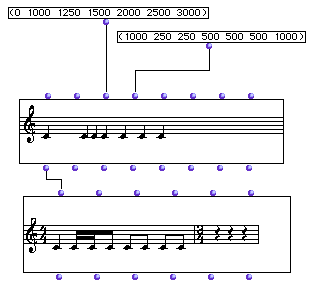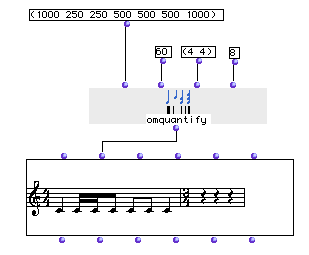OpenMusic Reference
omquantify

omquantify
(score module) -- performs a rhythmic transcription, converting a list of durations into a rhythm tree
Syntax
omquantify durs tempi measures max/ &optional forbid offset precis
Inputs
| name | data type(s) | comments |
|---|---|---|
| durs | a list of numbers | the durations to convert |
| tempi | a number or list thereof | the tempo or tempi to use for the transcription |
| measures | a list of lists | a list of time signatures to use in the format (a b) |
| max/ | an integer or tree thereof | the maximum permitted subdivision(s) of the beat |
| forbid | a list or tree of integers | optional; defaults to nil. A list of subdivisions which are not allowed in the transcription |
| offset | an integer | optional; defaults to 0. The offset will move the entire transcription to the right by the number of beats specified here |
| precis | a float between 0 and 1.0 | optional; specifies a level of precision in the transcription. Defaults to 0.5 |
Output
| output | data type(s) | comments |
|---|---|---|
| first | a rhythm tree |
Description
omquantify converts a list of durations, given in milliseconds into a rhythm tree.
The inputs tempi , measures , max/ , and forbid take either a single value, which is then applied globally, or a list of values, in which case they affect the transcription on the local level, as described below.
The tempi input specifies a tempo for the transcription. If a list is given, the different tempi are used for each consecutive measure of transcription.
The measures input takes either a single time signature, which is used for the entire transcription, or a list in the form (a b) or a list, i.e. ((4 4) (6 8)).
 | A minor feature
| A minor feature
—|—
The last measure of the transcription may have a time signature with one fewer beats than the indicated time signature; this has not affected the transcription. We are working on this and it should be fixed soon.
max/ allows you to set the maximum number of subdivisions in a beat, which is always the second number of the time signature, even in ternary meters. Setting it to 4 in a (4 4) time signature will set 16th as the smallest permitted note value. Setting it to 4 in (6 8) will set 32nds as the smallest. If max/ is an integer, it will be applied globally. Otherwise, max/ may be a tree, a list of lists of integers in which each list contains the maximum allowed subdivisions for each beat of the measure, for example ((4 3)) in a (2 8) time signature will allow up to 4 subdivisions of the first eighth note and up to 3 subdivisions of the second. You are not obliged to specify a sublist for each measure- leaving ((4 3)) in the above example will apply those subdivision limits to each measure.
forbid allows you to either prevent or force subdivisions of the beat. Like max/ , you may use a tree to specify local settings. If you use a simple list of integers, these subdivsions will be forbidden globally in the transcription. Make sure these values don’t conflict with the settings of max/ or you may lose notes in the transcription. You can use a list of lists to specify subdivisions to forbid on a measure-by-measure basis rather than globally: ((3) (5 6)) will forbid triplets in the first measure and quint- and sextuplets in the second. Using the empty set () for a measure indicates that all subdivisions are permitted up to the maximum set at max/ . You may add another level of nesting to specify the subdivisions to forbid on a beat-by-beat basis: (((3 5) 3) (5 6)) is like the last example, except that within the first measure, the first beat will have no triplets or quintuplets, while the second beat will have no quintuplets, while triplets are permitted. The length of these sublists will obviously depend on the measure lengths you have set. Note also that the OM considers the ‘beat’ to be whatever is in the denominator of the time signature, even in ternary meters.
forbid also allows you to force, rather than suppress, certain subdivisions either on the global, measure, or beat level. To do this, add a ! at the beginning of any sublist. ((! 3 4) (5)) Will force subdivisions of 3 or 4 in the first measure while forbidding quintuplets in the second.
Let’s look at the following example using all the possibilities:
(((5 4) () (! 3 6) ()) (() () (8 7) ()) (3 2) ())
indicates that:
-
first measure
-
first beat - subdivisions of 5 and 4 forbidden
-
second beat - no restrictions
-
third beat - only subdivisions by 3 and 6 permitted
-
fourth beat - no restrictions
-
-
second measure
-
first beat - no restrictions
-
second beat - no restrictions
-
third beat - subdivisions by 8 and 7 forbidden
-
fourth beat - no restrictions
-
-
third measure
- all beats - subdivisions by 3 and 2 forbidden
-
fourth measure
- all beats - no restrictions
If your settings do not allow enough precision or subdivisions of the beat, they may cause OM to drop some notes, in which case, a warning like this will appear in the listener:
? Warning: with the given constraints, 2 notes are lost while quantizing
offset is a number of beats (the denominator of the first measure) to skip; the entire sequence is moved to the right by the number of beats specified here.
precis is a decimal value between 0 and 1.0 which controls the precision of the transcription. Lower values produce simpler transcriptions. Higher values produce more accurate transcriptions.
When you connect a Chord-seq directly to a Voice :

omquantify is called automatically to convert the durations of the Chord- seq into a rhythm tree for the Voice. In fact, Voice uses omquantify as a method. You can adjust the parameters for this automatic omquantify in the preferences, under “Quantify Preferences.” Note that the omquantify module will still have its own defaults and behave accordingly- the preferences are only for the Voice object. See the section on Preferences.
A simple omquantify example
###

This example works well with very little help from omquantify since the durations divide evenly into the tempo specified. Try changing the tempo and the maximum number of subdivisions. Then add the optional precis input and set the precision to 0, then to 1.0 to see the difference.
| Prev | Home | Next |
|---|---|---|
| omif | Up | orbites |